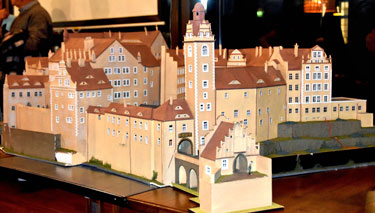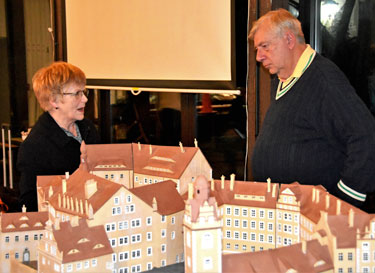 On 12 October Bangor Historical Society welcomed Richard Parkinson as the speaker. His subject was Colditz: Escapes and Escapades. He brought an impressive model of the castle complex. Colditz originated in the eleventh century as a hunting lodge for the Kings of Saxony. During the Second World War it was known as Oflag IVC. The castle had over 700 rooms and 90’ high walls. One part was for the prisoners and the other for the German staff. Measures to prevent escape included over 200 guards, 18 sentry posts, barbed wire and illuminations at night. Code words were changed regularly and the guards changed every 5-6 months.
On 12 October Bangor Historical Society welcomed Richard Parkinson as the speaker. His subject was Colditz: Escapes and Escapades. He brought an impressive model of the castle complex. Colditz originated in the eleventh century as a hunting lodge for the Kings of Saxony. During the Second World War it was known as Oflag IVC. The castle had over 700 rooms and 90’ high walls. One part was for the prisoners and the other for the German staff. Measures to prevent escape included over 200 guards, 18 sentry posts, barbed wire and illuminations at night. Code words were changed regularly and the guards changed every 5-6 months.
Among the prominent prisoners were Giles Romilly, a nephew of Winston Churchill and a Lt. Michael Alexander who claimed that his uncle was Field Marshall Alexander. Hitler hoped to use such prisoners as bargaining chips. As well as Britons, other nationalities included the French, Dutch and Poles. An international escape committee was established to prevent accidental confusion.
Red Cross and personal parcels were very important as contents could be bartered for other goods. Home parcels were used to smuggle goods. Codes were developed eg on handkerchiefs and fictitious addresses so that the prisoners would know which parcels contained smuggled goods. The French broke into the parcel office before the Germans could discover the goods. Prisoners kept busy with sports, plays, talks and puppet shows.
 Mr Parkinson then detailed some of the escapes which occurred. One man devised a blanket covered with leaves. He got out of the castle, but was captured two miles from the town. One problem was the irregular roll calls which the Germans used to detect escapes, tunnelling etc. The Dutch had dummies dressed in uniform. The British used ‘ghosts’, men who hid and then replaced the men escaping. Civilian clothes, passes etc had to be prepared for the escapees. The French started a tunnel at the top of the clock tower, but it was discovered after 250 days, just before the prisoners were due to go out. The first successful escape was made by a Frenchman who used a blind spot to dive into a hollow. He reached Switzerland. Airey Neave dressed as a German soldier and got past the first gate. At the second he was stopped – he did not look German enough. He made another attempt together with a Dutch prisoner. During a performance they escaped through an access point in the theatre celling. Dressed as German officers they managed to to get out of the castle and reached Switzerland 48 hours later.
Mr Parkinson then detailed some of the escapes which occurred. One man devised a blanket covered with leaves. He got out of the castle, but was captured two miles from the town. One problem was the irregular roll calls which the Germans used to detect escapes, tunnelling etc. The Dutch had dummies dressed in uniform. The British used ‘ghosts’, men who hid and then replaced the men escaping. Civilian clothes, passes etc had to be prepared for the escapees. The French started a tunnel at the top of the clock tower, but it was discovered after 250 days, just before the prisoners were due to go out. The first successful escape was made by a Frenchman who used a blind spot to dive into a hollow. He reached Switzerland. Airey Neave dressed as a German soldier and got past the first gate. At the second he was stopped – he did not look German enough. He made another attempt together with a Dutch prisoner. During a performance they escaped through an access point in the theatre celling. Dressed as German officers they managed to to get out of the castle and reached Switzerland 48 hours later.
Mike Sinclair the ‘Red fox’ was the only POW to be killed. On his ninth attempt he was shot going over the wire and then running zig zag from the recreation area. A successful escape was made by Billie Stephens from Holywood who was one of four men to escape from a window. The prisoners’ orchestra played or stopped to signal whether guards were in the vicinity. The four reached Switzerland successfully. In all 32 ‘home runs’ were made, twelve of them by the French.
